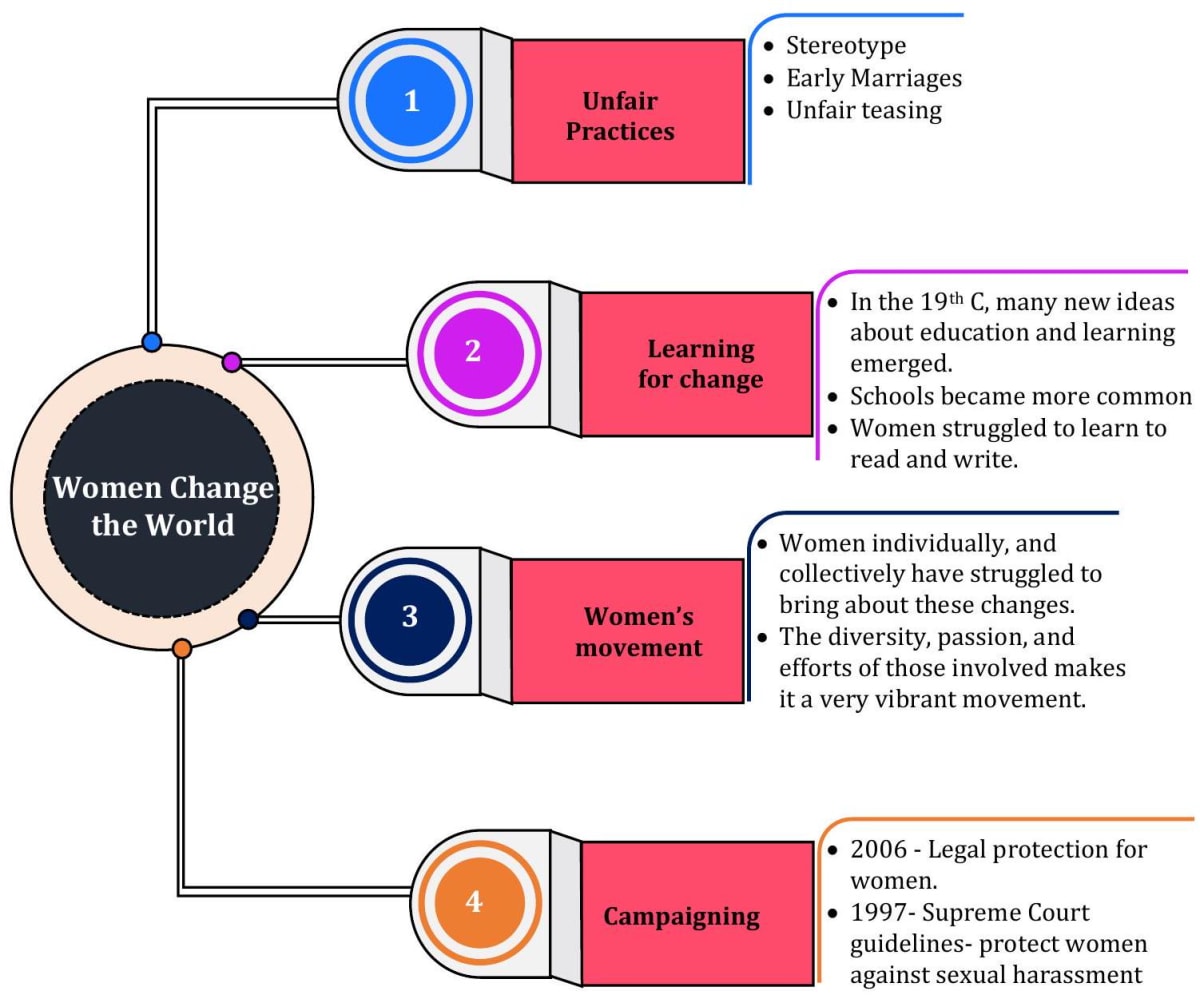Women Change The World

"Women's work in the home is not recognised as work. We also read how doing household work and taking care of family members is a full-time job and there are no specific hours at which it begins or ends."
1.0Introduction
- In this chapter, we will look at work outside the home, and understand how some occupations are seen to be more suitable for men than for women.
- We will also learn about how women struggle for equality.
- Getting an education was, and still is, one way in which new opportunities were created for women.
- This chapter will also briefly trace the different types of efforts made by the women's movement to challenge discrimination in more recent years.
2.0Fewer Opportunities and Rigid Expectations
- Women are good at only certain jobs. For example, many people believe that women make better nurses because they are more patient and gentler.
- This is linked to women's roles within the family. Similarly, it is believed that science requires a technical mind and girls and women are not capable of dealing with technical things.
- Because so many people believe in these stereotypes, many girls do not get the same support that boys do to study and train to become doctors and engineers.
- In most families, once girls finish school, they are encouraged by their families to see marriage as their main aim in life.
- It is important to understand that we live in a society in which all children face pressures from the world around them.
- Sometimes, these come in the form of demands from adults.
- At other times, they can just be because of unfair teasing by our own friends.

- Boys are pressurised to think about getting a job that will pay a good salary.
- They are also teased and bullied if they do not behave like other boys.
3.0Learning For Change
- Going to school is an extremely important part of your life.
- As more and more children enter school every year, we begin to think that it is normal for all children to go to school.
- Today, it is difficult for us to imagine that school and learning could be seen as "out of bounds" or not appropriate for some children.
- But in the past, the skill of reading and writing was known to only a few.
- Most children learnt the work their families or elders did.
- For girls, the situation was worse. In communities that taught sons to read and write, daughters were not allowed to learn the alphabet.
- Even in families where skills like pottery, weaving and craft were taught, the contribution of daughters and women was only seen as supportive.
- For example, in the pottery trade, women collected the mud and prepared the earth for the pots.
- But since they did not operate the wheel, they were not seen as potters.

- In the nineteenth century, many new ideas about education and learning emerged.
- Schools became more common and communities that had never learnt reading and writing started sending their children to school. But there was a lot of opposition to educating girls even then.
- Yet many women and men made efforts to open schools for girls.
- Women struggled to learn to read and write.
- Let us read about the experience of Rashsundari Devi (1800-1890), who was born in West Bengal, some 200 years ago.
- At the age of 60, she wrote her autobiography in Bangla.
- Her book titled Amar Jiban is the first known autobiography written by an Indian woman.
- Rashsundari Devi was a housewife from a rich landlord's family.
- At that time, it was believed that if a woman learnt to read and write, she would bring bad luck to her husband and become a widow!
- Despite this, she taught herself how to read and write in secret, well after her marriage.
- "I would start working at dawn, and I would still be at it until well beyond midnight. I had no rest in between. I was only fourteen years old at the time. I came to nurture a great longing: I would learn to read and I would read a religious manuscript. I was unlucky, in those days women were not educated. Later, I began to resent my own thoughts. What is wrong with me? Women do not read, how will I do it? Then I had a dream: I was reading the manuscript of Chaitanya Bhagabat (the life of a saint)... Later in the day, as I sat cooking in the kitchen, I heard my husband say to my eldest son: "Bepin, I have left my Chaitanya Bhagabat here. When I ask for it, bring it in." He left the book there and went away. When the book had been taken inside, I secretly took out a page and hid it carefully. It was a job hiding it, for nobody must find it in my hands. My eldest son was practising his alphabets at that time. I hid one of them as well. At times, I went over that, trying to match letters from that page with the letters that I remembered. I also tried to match the words with those that I would hear in the course of my days. With tremendous care and effort, and over a long period of time, I learnt how to read..."

- After learning the alphabet, Rashsundari Devi was able to read the Chaitanya Bhagabat.
- Through her own writing she also gave the world an opportunity to read about women's lives in those days.
- Rashsundari Devi wrote about her everyday life experiences in details.
- There were days when she did not have a moment's rest, no time even to sit down and eat!
4.0Schooling And Education Today
- Today, both boys and girls attend school in large numbers.
- Yet, as we will see, there still remain differences between the education of boys and girls.
- India has a census every 10 years, which counts the whole population of the country.
- It also gathers detailed information about the people living in India - their age, schooling, what work they do, and so on.
- We use this information to measure many things, like the number of literate people, and the ratio of men and women.
- According to the 1961 census, about 40 per cent of all boys and men ( 7 years old and above) were literate (that is, they could at least write their names) compared to just 15 per cent of all girls and women.
- In the most recent census of 2011, these figures have grown to 82 per cent for boys and men, and 65 per cent for girls and women.
- This means that the proportion of both men and women who are now able to read and have at least some amount of schooling has increased.
- But, as you can also see, the percentage of the male group is still higher than the female group.
- The gap has not gone away.

- Here is a table that shows the percentage of girls and boys who leave schools from different social groups including Scheduled Caste (SC) and Scheduled Tribe (ST). Average Annual Drop-out Rate in School Education (2014-15)
- You have probably noticed in the above table that SC and ST girls leave school at a rate that is higher than the category 'All Girls'.
- This means that girls who are from Dalit (SC) and Adivasi (ST) backgrounds are less likely to remain in school.
- The 2011 census also found that Muslim girls are less likely, than SC and ST girls, to complete primary school.
- While a Muslim girl is likely to stay in school for around three years, girls from other communities spend around four years in school.
- There are several reasons why children from Dalit, Adivasi and Muslim communities leave school.
- In many parts of the country, especially in rural and poor areas, there may not even be proper schools nor teachers who teach on a regular basis.
- If a school is not close to people's homes, and there is no transport like buses or vans, parents may not be willing to send their girls to school.
- Many families are too poor and unable to bear the cost of educating all their children.
- Boys may get preference in this situation.
- Many children also leave school because they are discriminated against by their teacher and classmates.
5.0Women's Movement
- Women and girls now have the right to study and go to school.
- There are other spheres - like legal reform, violence and health - where the situation of women and girls has improved.
- These changes have not happened automatically.
- Women individually, and collectively have struggled to bring about these changes.
- This struggle is known as the Women's Movement. Individual women and women's organisations from different parts of the country are part of the movement.
- Many men support the women's movement as well.
- The diversity, passion and efforts of those involved makes it a very vibrant movement.
- Different strategies have been used to spread awareness, fight discrimination and seek justice.

6.0Campaigning
- Campaigns to fight discrimination and violence against women are an important part of the women's movement.
- Campaigns have also led to new laws being passed.
- A law was made in 2006 to give women who face physical and mental violence within their homes, also called domestic violence, some legal protection.
- Similarly, efforts made by the women's movement led the Supreme Court to formulate guidelines in 1997 to protect women against sexual harassment at the workplace and within educational institutions.

- In the 1980 s, for example, women's groups across the country spoke out against 'dowry deaths' - cases of young brides being murdered by their in-laws or husbands, greedy for more dowry.
- Women's groups spoke out against the failure to bring these cases to justice.
- They did so by coming on to the streets, approaching the courts, and by sharing information.
- Eventually, this became a public issue in the newspapers and society, and the dowry laws were changed to punish families who seek dowry.
7.0Raising Awareness
- An important part of the women's movements' work is to raise public awareness on women's rights issues.
- Their message has been spread through street plays, songs and public meetings.
8.0Protesting
- The women's movement raises its voice when violations against women take place or for example, when a law or policy acts against their interests.
- Public rallies and demonstrations are a very powerful way of drawing attention to injustices.
- Laxmi Lakra, a woman from a poor tribal family in Jharkhand, was the first woman engine driver.
- Rashsundari Devi, born in West Bengal, was a housewife from a rich landlord's family. She wrote Amar Jiban.
9.0Glossary
- Stereotype - It refers to the practice of believing unfairly that all people belonging to a particular group are bound to have certain fixed characteristics.
- Discrimination - It means to treat people unequally or with disrespect. It takes place when we treat someone differently.
- Census - It means to collect information about people living in India such as age, literacy rate, sex ratio, etc. In India, census is done every 10 years.
- Campaigning - It is a series of activities designed to produce a particular result.
- Violation - It is the act of doing something which is not allowed by a law or rule.
10.0Mind Map

Related Article:-
Join ALLEN!
(Session 2026 - 27)
Choose class
Choose your goal
Preferred Mode
Choose State